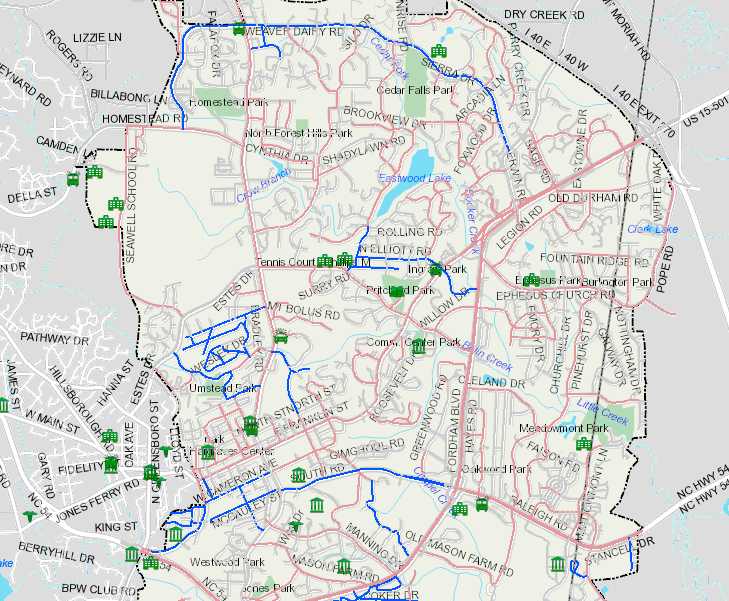
Chapel Hill 2030?
A quick update on yesterday’s report (“Radical Shift In Vision For Downtown”) about the Downtown Development Framework and Action Plan charrette.
First, the Downtown Partnership has posted the DRAFT Downtown Development Framework Presentation here [PDF:14M]. The Town’s webserver had a little trouble downloading it so I’ve also put a copy here.
The presentation made by Kling-Stubbins fleshed out a bit more of the proposal and added additional context, so what you see here is not the whole story.
Second, a few observations.
I was pleased to see a wide range of comments I heard during last April’s forums make it into yesterday’s presentation.
I was also pleasantly surprised to see how many of the specific comments I made were reflected in the draft.
For instance, noting “Wallace deck provides no active street edge on East Rosemary” (and creating a commercial component along that edge and other potential decks should be a design recommendation) and that defining the “edges of Downtown” along with creating a better “transition to residential neighborhoods” should be an integral priority.
Beyond that, they also captured my concern that the Town isn’t addressing the issue of “downtown/higher density … creeping up MLK”.
I had echoed a common, but understandable, complaint from both the development and wider community that the Town’s “redevelopment review is too subjective” (you might recall my underlining Council member Ed Harrison’s comment that the development special use permitting process was a “crap shoot” during last year’s election).
Further, they specifically quoted my comment that Downtown should be partially “about culture, not just commerce” (though Kling-Stubbins omitted my elaboration that Downtown is a common asset of and for the whole community).
Of course many folks share common concerns, like bolstering a “more visible Police presence” Downtown and have made similar suggestions. A lot of this ground has been tread over before.
As far as commercial development, Kling-Stubbins didn’t mention my call for affordable commercial/office space but did mention my suggestion we should encourage creation of commercial “incubators”. They also referenced my concern that our current leadership has “a perception that nobody works downtown” (I did for over 8 years and well understand that blindspot that used to plague policy creation).
Unfortunately, staff and the consultancy omitted the Town’s municipal fiber network infrastructure as a key Downtown economic development resource.
“Why don’t residents frequent Franklin St.?” is one question I’ve heard over and over through this and many other Downtown policy discussions. Solving that riddle, not just relying on attempts to increase the number of high-roller residents, is the real key to Downtown’s success.
Downtown shouldn’t be all work and no play.
It was great that several folks brought up the use of UNC’s “McCorkle Place for concerts and public events”. Sadly, the University just indicated that using McCorkle for public gatherings, a common practice a few decades ago, is untenable. Big events there pose a serious environmental threat to the grand old trees spread throughout that University commons.
A plank of my election campaigns going back to 2005, addressing the need for “more family oriented public spaces”,”fountains [I meant drinking]” and “pocket parks” Downtown also made the grade.
The consultants also picked up on the idea of siting both a “library”, which the Chamber’s Aaron Nelson help flog last year and Commissioner Barry Jacobs promoted this, and a “middle school downtown” (I had observed that the old University Chrysler building was larger than my elementary school and suggested it might be converted).
It wouldn’t be Chapel Hill without some discussion of transit.
“Increasing night time bus service” and creating more direct routes to Downtown from Hwy. 54 and 15-501 , both comments I frequently heard (and made myself) at the two previous forums, led to some more involved discussion during the informal Q & A session following the presentation.
In terms of a comprehensive facility for managing multiple modes of transport, Kling-Stubbins used a design example for the proposed transit center (lining the new street occupying the eastern margin of Lot $5) that was architecturally like Durham’s new facility (which I covered last year Multi-Modal Design I Appreciate).
Again, the consultants manage to catch some of the best ideas from last April including riffing on improved transportation linkages and walkability throughout Downtown.
I really liked that Kling-Stubbins was willing to challenge the general view that Downtown only needs a series of tweaks by sketching out a new system of pedestrian and bike friendly roads – real linkages – in central Chapel Hill.
A revolutionary approach I hope will shake up some of our more uncompromising conceptions of Downtown.
That said, while “high concept” can be enlightening, there are a series of very practical, pragmatic and cost-effective tweaks that were missing from the proposal.
One example, dealing with the grease depository behind Franklin Street’s 100 block. Fixing cracked or handicap inaccessible sidewalks were among others not even acknowledged.
One practical solution that wasn’t omitted, improved signage. Specifically, creating directories of downtown services and posting them throughout the central district between Franklin St./Rosemary St. (in Planning parlance “way signage”). This is an idea I’ve lobbied for since my run in 2005 (and again as a member of the Downtown Parking Task Force).
A bit further afield, Council member Laurin Easthom’s call for another Downtown trolley along with a suggestion made by several folks to convert the intersection of Columbia/Franklin St. into a “scramble” zone (red lights both directions, free-for-all getting across).
Many of the concerns and suggestions I heard during the (now defunct) Sustainability Visioning Task Force’s forums last year also arose during both last April’s initial and yesterday’s Action Plan public outreach. There was also quite a bit of overlap with comments made during the University Square redevelopment forums, the Campus-to-Campus Bike Connector discussions, the recent Police outreach effort and quite a few other public events sponsored by the Town or University in the last few years.
Unfortunately it appears that the Town hasn’t provided Kling-Stubbins that citizen input and, at least at this time, there is no plan to integrate the concerns/suggestions voiced during these different events in crafting the new Downtown action plan.
Seems like another waste of citizens’ valuable efforts to influence our Town’s direction. A bit discouraging.
The core themes of the framework revolved around a compact, connected, green design for Downtown with key anchoring elements to draw folks in. Or, to quote
- Keep downtown Compact and walkable but identify new development opportunities
- Improve Connections…cars, buses, peds and bikes
- Develop parking and visitor facilities to Anchor downtown and deliver customers
- Create new Green public space and advance environmental and financially sustainable development practices
That high flying rhetoric looks good on a chart but the emphasis on “delivering customers” and the use of “green” is a bit troubling.
What happened to the idea that Downtown, which all of us are invested in, is a community asset – a commons for culture, commerce and community to meet in?
The faux “downtown” at Durham’s Southpoint might be designed to lure customers, Chapel Hill’s Downtown needs to be designed to lure community.
And “green”?
Without a sincere and concrete commitment to make measurable and enforceable “green” goals a part of the framework (something the Council wasn’t willing to do with their own Lot $5 project), this rhetoric amounts to little more than “green washing” – a PR tactic we’ve seen used to promote some fairly substandard projects throughout Town.
Of course, this is just the first draft of the first steps proposed.
Both the consultants and our Town staff – Economic Officer Dwight Bassett and Downtown Partnership’s Jim Norton – agree that much more resident review is needed to hammer out the final plan.
More analysis and commentary on the revolutionary new layout for Downtown, the troubling suggestion of financing improvements using TIFs (tax incremental funding), the reliance on the recent flawed parking study and interesting examples of the consultants misreading of Chapel Hill’s character coming soon.




